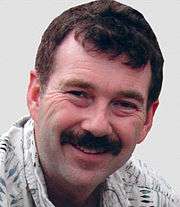Tim Patterson

R. Timothy Patterson is a professor of geology at Carleton University, where he is Director of the Ottawa-Carleton Geoscience Centre in Ottawa, Ontario, Canada. He is also a Senior Visiting Fellow in the School of Geography, Queen's University of Belfast, Northern Ireland. He holds a B.Sc. in Biology, B.A. in Geology, both from Dalhousie University, Halifax, Nova Scotia and a Ph.D. in geology from the University of California at Los Angeles (UCLA).
Professional experience
Patterson serves as Canadian leader of UNESCO International Geological Correlation Program (IGCP) Project 495 "Quaternary Land-Ocean interactions", which is mandated to study the record of sea level change past and future and has been Principal Investigator of large Natural Sciences and Engineering Research Council of Canada (NSERC) and Canadian Foundation for Climate and Atmospheric Sciences (CFCAS) projects, examining high-resolution climate records from marine basins off the west coast of Canada.
He was a founding editor of the journal Palaeontologia Electronica (Executive Editor, 1998–2000), is Associate Editor for the Journal of Foraminiferal Research and is past associate editor of the journal Micropaleontology.
Research
As of 2007, Patterson has published over 120 articles in peer-reviewed journals. His research emphasizes the dynamics of climate and sea level change through the last few thousand years. He also studies the environmental impact of land use change in agricultural and urbanized settings. In several recent publications he has presented evidence that cosmoclimatological drivers are the primary driver of climate change. He has stated that as a result of his research, he is sceptical of many of the climate change scenarios projected by the Intergovernmental Panel on Climate Change (IPCC). In recognition of his research efforts Patterson was awarded a 2002-2003 Carleton University Research Achievement Award for 'outstanding research'.
Climate change
In June 2007 he authored a general interest article in the Financial Post (the business section of the National Post, a major Canadian newspaper) predicting general climatic cooling as the sun enters Solar cycle 25 about 2018. He based his prediction on the close correlation between solar and climate cycles in his high resolution analysis of late Holocene cores deposited under anoxic conditions within deep Western Canadian fjords.[1] Solar cycle 25 will be as weak as solar cycles in the early 19th century during a very cold phase of the Little Ice Age. At this time drought and short growing seasons would have made present day agricultural practices used in areas like the grain growing region of western Canada impossible. In a June 2007 presentation to the annual meeting of the Ontario Agri Business Association in Huntsville, Ontario he stated that "climatic cooling associated with Solar Cycle 25 should be of concern to the Canadian agricultural sector. During any climatic warming agricultural methods used to the south can be immediately adapted. However, cooling such as may occur beginning about 2018 would be an agricultural and national disaster as no one is farming north of us."
A similar approach based on generic geochemical data and astrophysical deliberations was published by Jan Veizer and Nir J. Shaviv in GSA Today,[2] describing a reduced (capped) influence of carbon dioxide to Climate Change and attributing a more significant influence to cosmic rays. While the mechanism seems not yet to be fully understood, the empirical data showed a suitable fit. The results, not the thesis are in line with the minimal level of the consented temperature predictions of the IPCC.
Selected publications
- Patterson, R.T., Prokoph, A., Reinhardt, E., and Roe, H., 2007. "Climate cyclicity in anoxic marine sediments from the Seymour-Belize Inlet Complex, British Columbia". Marine Geology.
- Patterson, R.T., Dalby, A.P., Roe, H.M., Guilbault, J.-P., Hutchinson, I., and Clague, J.J. 2005. "Relative utility of foraminifera, diatoms and macrophytes as high resolution indicators of paleo-sea level". Quaternary Science Reviews, v. 24, p. 2002-2014.
- Chang, A.S., and Patterson, R.T. 2005. "Climate shift at 4400 years BP: Evidence from high-resolution diatom stratigraphy, Effingham Inlet, British Columbia, Canada". Palaeogeography, Palaeclimatology, Palaeoecology. v. 226, 72-92.
- Patterson, R.T., Prokoph, A., and Chang, A.S. 2004. "Late Holocene sedimentary response to solar and cosmic ray activity influenced climate variability in the NE Pacific". Sedimentary Geology. 172, p. 67-84.
- Prokoph, A., and Patterson, R.T. 2004. "Application of wavelet and discontinuity analysis to trace temperature changes: Eastern Ontario as a case study. Atmosphere Ocean". v. 42, p. 201-212.
- Patterson, R.T., Fowler, A.D., and Huber, B., 2004. "Evidence of Hierarchical Organization in the Planktic Foraminiferal Evolutionary Record". Journal of Foraminiferal Research, v. 34 (2), p. 85-95.
- Patterson, R.T., Prokoph A.,Wright, C., Chang, A.S., Thomson, R.E., and Ware, D.M., 2004. "Holocene Solar Variability and Pelagic Fish Productivity in the NE Pacific". Palaeontologia Electronica, v. 6 (1). 17 pp.
- Gehrels, W.R., Milne, G.A., Jason R. Kirby, J.R., Patterson, R.T., and Belknap, D.F., 2004. "Late Holocene sea-level changes and isostatic crustal movements in Atlantic Canada. Quaternary International". v. 120, p. 79-89.
Academic group memberships
- Director, Coquina Press, publisher of Palaeontologia Electronica
- Geological Society of America (GSA)
- Society for Sedimentary Geology (SEPM)
- North American Micropaleontological Society (NAMS)
References
- ↑ R. Timothy Patterson (20 June 2007). "Read the sunspots". Financial Post. Retrieved 2007-08-25.
- ↑ Shaviv, Nir J.; J. Veizer (2003). "Celestial driver of Phanerozoic climate?" (PDF). GSA Today. Geological Society of America. 13 (7): 4–10. doi:10.1130/1052-5173(2003)013<0004:CDOPC>2.0.CO;2.